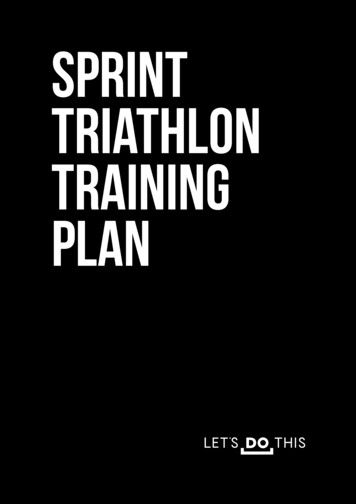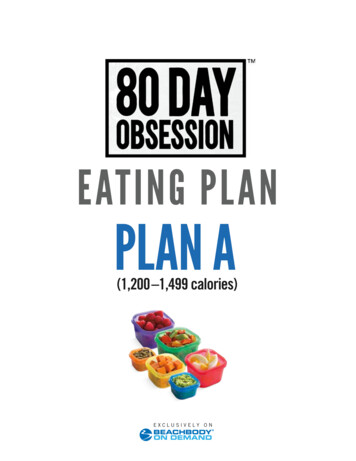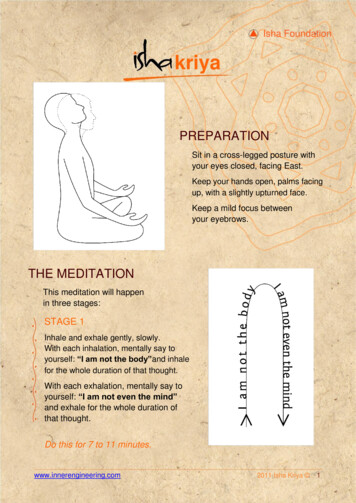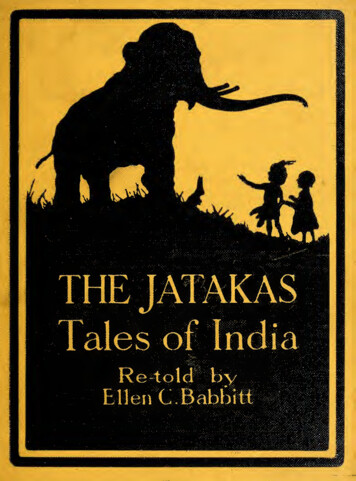
Transcription
Get4.0 1
2
First of all, let me congratulate you.You wouldn’t have taken time to start reading it if you were not ready to change.This shows you’re ready to begin your transformation journey.JCJITENDRA CHOUKSEY,ISSA Sports Nutrition Specialist, Founder, Director At FITTRDISCLAIMERBe informed that this book is solely written based on my personal experience and I, in no way claim, thatthe information in it is 100% verified, as there are more and more researches coming every day, discretion isadvised. Furthermore, nothing contained herein is to be construed as Medical Advice. Use of any supplements/drugs and exercise regimen should only be done under the directions and auspices of a licensed physician.The writer does not claim to be a medical doctor nor does he purport to issue medical advice. 3
INDEXIntroduction 05The BasicsTrainingMetabolism 08The Actual Energy 11Why Do I Feel Hungry? 12Role of Water 13Conclusions 14Muscle Fibre Types 34How To Train Your Muscle Fibre Type 35Time Under Tension or T.U.T 36Cardio 37NutritionCalculating the BMR 16Total Calorie Needs Example 17Lean Mass Calculation 18Low Carb Diet 19My Personal Diet 20Zone Diet 22Depletion Diet 22The Ketogenic diet 25Peak Week and Contest Prep 29Reverse Dieting 30Dieting Road Map 30 4SupplementationProtein 43Creatine 43BCAA 44ZMA 44Micronutrients 44Hormones 45
84kgs weight16% bodyfatIntroductionIt was 2013. It had been almost 6 years then that I hadbeen working out on and off, based on what “experts”have been telling me. However, after marriage, I puton a lot of weight! Happens right? Office stress andmanaging the house budget further deterioratedmy condition. I was not able to go to the gym foralmost a year, resulting in my muscle mass gettinglost while the fat took a leap forward. However, inNovember 2013, after changing my stressful job,I started going back to the gym again. I weighedaround 84kgs with a body fat of about 16%. This wasthe time Krish-3 was being promoted in India, andthere were posters of Hrithik Roshan in every nookand corner. Aesthetics were in! I too wanted to getthat chiselled look and beach body which I couldhave throughout the year rather than bulking formonths and then again cutting back for months. Iwas tired of that nonsense.2013ONE YEAR LATERSo, I knew right then what I wanted, and I had a targetin mind too, but I did not know how to reach there. Idid not have any mentor. All I knew was the typicalstuff everyone knew bodybuilding fundas that areprevalent through hearsay for eg., “Creatine is notgood, it damages the liver and causes bloating, andwater retention”, “Heavyweights for gaining massand lightweight for losing”, “More reps are good forcutting.”And other hazy misinformation in circulation. I didn’teven bother questioning these ideas – It had workedfor me so far after all! I had a decent body. Usingthose same ideas from hearsay, I knew I had to leanout first to reduce my fat, so I thought to myself, “Let’sdo cardio every day along with weight training.” And 5201473kgs weight7% bodyfat
so, I cut my calorie intake. After around 3 months, I looked like this. *I was about 73 kgs now, so I lost a total of 11kgs, which for most people would be amazing.But for me, it was complete a disappointment!I checked my body fat levels, they were only down by 2%. While I had shed 11 kgs of bodyweight, I had lost only 2% body fat! Then what exactly did I lose? Was it muscles?Bang on! What I had lost was a lot of muscles! And on top of that, I had messed up mymetabolism, getting to a position where I was barely consuming 1500 calories a day!Anything I was eating was converted to fat, and that made me reduce my calories more andmore to keep off that fat. All in all, it was a vicious cycle I was on, and my physical conditionand metabolism kept declining until I came across this article that changed my wholeperspective. Once the truth registered in my mind, it gave rise to a tremendous urge to learnmore about how the body responds to food and exercise. Then all I did was read more andmore. And as I did so, I realized the degree to which misinformation and misconceptionswere prevalent in the current scenario & how these so-called “experts” were messing upan entire generation of health enthusiasts by feeding them wrong information! That waswhere the foundation to my whole vision was laid - the foundation that led directly to thisdocument you are reading.This complete guide is built on my personal experience, my learning, and my journey from14% body fat to 4.6% body fat. Neither did I do anything stupid, nor was I dehydrated. It isbelieved that bodybuilders are very weak on the day of the competition. Hey, I did 39 strictpull-ups and a workout too!But enough of me, let’s get to you now. 6
BASICSBASICSChapter 1 METABOLISM 08 ROLE OF WATER 13 THE ACTUAL ENERGY 11 CONCLUSIONS 14 WHY DO I FEEL HUNGRY? 12 7
The BasicsYou have to understand one thing - we’re not actors who roam around with their personalchefs who cook us personalized high protein meals! We don’t even have a lot of money tospend on all sorts of pre-workouts, fat-burners, casein, hydro- whey, and all that high-endexpensive stuff. I, myself, was an ordinary middle-class husband and a father, who workedfor a software company. So, there are none of those luxuries that glamour brings, neitherdo you need any of that. We learn to do the best with whatever we have available in ourbudget.Before getting to it, please understand a few things very clearly:1. Fitness is science. If you’re getting desired results without needing a proper plan fornutrition and workout, then good for you, you can stop reading this document rightaway.2. To lose weight, you have to take lesser calories than your Total Daily Energy Expenditure(TDEE)*, to gain weight you have to take more calories than that. Simple and logical.That’s it, and there is absolutely NO WAY around these two guidelines. Let science guideyour transformation journey, not bro-science.I figured the best way to tell you everything would be to start from the start. It may beboring initially, as it is all about the basic science behind our health, but trust me, you’ll seealmost 99% of the things are relevant. So please don’t skip anything and if possible, re-readit multiple times. Good luck!MetabolismYour body is like a car - it needs fuel to run. However, unlike a petrol or diesel car, your bodycan use multiple fuels. In simple words, the process in which your body uses the fuel toprovide energy to your body is called Metabolism.The food contains ingredients which your body can use as fuel. But even this fuel is not yetin the form of energy that can be used immediately! If I give you a fully charged battery, tryusing it for baking an egg. Possible? No.Having an energy-containing fuel does not mean that it is ready to use.It all starts with food, and its Metabolically Active Ingredients Fat Fiber Long Carbohydrates Short Carbohydrates (Sugar in other words) ProteinFat contains 9 calories (kilocalories) per gram, and Carbohydrates and Protein contain 4calories per gram each. While fibres do contain about 2 kcals, they are critical in makingdigested food leave your body. They help in digestion as well. Here’s a more straight forward 8
presentation:1g of Fat 9 Calories1g of Carbohydrates 4 Calories1g of Protein 4 CaloriesSo far, we have discussed the fuel sources, but what exactly are these fuels that we’ve beentalking about? What do they comprise?Let’s have a look: Your body can extract at least the following three kinds of fuel fromwhat you ingest:1.Fatty Acids5.Fibres (used for excreting ingredients)3.Amino Acids7.Shorter carbohydrates (sugars) Glucose2.4.GlucoseFat Fatty Acids6. Long carbohydrates Shorter Glucose8. Proteins Amino AcidsWe know about the fuels now. It’s time to understand how they are stored in the body.Different fuels are stored in various forms, amounts and in different locations.1.Fatty acidsAlmost any cell can store fatty acids, they can also be transported directly in thebloodstream - no conversion is needed. If it turns out that you do not have enough cellsto store all fatty acids, your body can quickly generate specialized ‘adipocytes’ (fat cells),which put together, form the so-called ‘adipose tissue’. As can easily be observed, thebody easily stores tens of kilos of fat. As each kilo of fat can power an individual for manydays, an average person actually carries enough energy in the form of fat to survive fora month. An overweight person often has enough fuel to survive for many months!But hey! All this doesn’t make fat terrible. Just remember, you can survive without carbs,but without essential fats, your brain will simply stop working. So never ever cut down fatentirely from your diet. You need essential fats every single day for your survival!2. GlucoseGlucose is a tiny molecule and quickly travels from cell to cell. This makes it easilytransportable. This mobility is not very well suited for actually storing sugars, so forstorage, sugars are converted to glycogen. Glycogen is a molecule which consists ofsmaller glucose. This size and aggregation make it easier to store glucose.As glycogen, sugar is stored in the liver and in muscles. Both liver and muscles canconvert glucose to glycogen. The liver can convert glycogen back to glucose, butmuscles cannot. Muscles can, however, use glycogen directly if needed, or release it into 9
the bloodstream.What is very notable, is the limited amount of sugars which can be actually stored.Ingested glucose and small carbohydrates like table sugar travel nearly directly tothe bloodstream. While this allows the body to rapidly utilize ingested sugar, what thiseventually means is that the amount of glucose allowable in the blood can be easilyexceeded.People of average weight will generally have in the order of 5 grams of glucose intheir blood at any specific time. Levels above 10 grams are considered too high.This means that a regular candybar, which contains approximately30 grams of sugar, actually poses a great challenge to the body.When glucose arrives (via the food we eat) over 10 grams, the body releases insulin,which instructs the liver and muscles to absorb glucose from the blood. Furthermore, allparts of your body, which can run on glucose start doing so as well. Consequently, theburning of fatty acids for energy production is reduced.Beyond the bloodstream, the body can store a few hundred grams of glucose. Amountsdiffer with the actual body mass and the physical condition of each individual body butare generally in the order of approximately 150 grams. The glucose storage can usuallybe depleted in a single day, making it a short-term fuel.Complex carbohydrates cannot be transferred directly to the bloodstream and must beconverted first, which can take quite some time. That is actually a good thing becausethis delay ensures that the blood isn’t overflooded with glucose.Remember, insulin spikes are bad as they indicate that your bodydoes not need to burn fat. So fat loss stops right there!3. Proteins and Amino AcidsThese are found throughout the body, either bunched up as proteins or freely availableamino acids. They are the building blocks and can be used to form muscle fibres, orcells, or lots of other things, all of which can also be broken down again into proteins oreven amino acids. It is a reversible process. Proteins are broken down into amino acids inthe intestine and then brought to the liver, where they are partly reassembled and partlyreleased into the bloodstream.Compared to glucose, a lot of protein is available for use at any one time. The bloodalone will contain in the order of approximately 100 grams. Compared to either glucoseor fatty acids, amino acids also have *vast* uses. It can also be stated that you ARE asignificant aggregation of amino acids! They make up your DNA and mostly everythingelse that is interesting in your body.I know it’s all so scientific, and you’re waiting to get to the part where all the ‘real’ actionbegins (the info that you can get your hands dirty with), but hold your horses for that!Whatever actionable items will come, comes precisely out of this scientific informationand is built on this information alone. So, don’t make the mistake of skipping these factsand figures! Keep reading. 10
The Actual EnergyNow, you have the petrol ready in the storage tank, but is that enough for your car to start?Certainly not. You’ll have to trigger the start button, and that is when the petrol combineswith air and is ignited in the combustion chamber, resulting in the release of a short burst ofvery powerful energy which will drive the pistons. In case of body, this energy is called ATP(Adenosine Tri-Phosphate)As I mentioned earlier, your body stores its energy in the form of the three different fuels. Tobe used, these fuels must each be converted to ATP. This can be done in lots of places.GlucoseGlucose, stored in the form of glycogen, can be converted into ATP by all cells containingmitochondria, which is the power-producing unit of the cell. Nearly all cells havemitochondria, which means almost all cells can convert glucose into ATP. Muscles caneven burn glycogen directly, without needing to convert it first into glucose.Fatty acidsPretty much the same goes for the site of metabolism of fatty acids, with the very notableexception of the brain. Fatty acids cannot cross the barrier into brain cells.The brain, however, uses loads and loads of energy in the form of glucose.Fatty acids, however, can be converted to ketones, which can partly power the brain. Butonly partially. It still needs glucose, and that glucose can come from protein breakdown(from your diet, or if you do not ingest enough protein, then by breaking down themuscles)Amino acidsCan be converted by the liver into glucose, or even into fatty acids.Almost everything
ISSA Sports Nutrition Specialist, Founder, Director At FITTR 4 INDEX Introduction 05 The Basics Metabolism 08 The Actual Energy 11 Why Do I Feel Hungry? 12 Role of Water 13 Conclusions 14 Nutrition Calculating the BMR 16 Total Calorie Needs Example 17 Lean Mass Calculation 18 Low Carb Diet 19 My Personal Diet 20 Zone Diet 22 Depletion Diet 22 The Ketogenic diet 25 .











